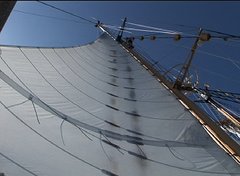
May 26, 2007. Washington Atoll. -- We approached Teraina (Washington) Atoll (one of the 32 islands and atolls that are part of the island nation of Kiribati) to compare this reef to Kiritimati (Christmas), Tabuaeran (Fanning) and Palmyra atolls. Teraina Atoll rises strikingly from the sea with a thick jungle of palms along the beaches. Our ship approaches to within a half-nautical mile of shore, and through the binoculars I can see kids running along the beach.
 It was a remarkable moment as the ship loomed offshore with the lower sails up. I wondered what the isolated islanders thought when they saw this remarkable tall ship approaching so closely. The approach to shore at Washington Atoll was extremely steep along the beach with huge breaking waves, and we were unable to land a Zodiac ashore but we did allow four swimmers to swim through the surf zone and onto the island.
It was a remarkable moment as the ship loomed offshore with the lower sails up. I wondered what the isolated islanders thought when they saw this remarkable tall ship approaching so closely. The approach to shore at Washington Atoll was extremely steep along the beach with huge breaking waves, and we were unable to land a Zodiac ashore but we did allow four swimmers to swim through the surf zone and onto the island.We launched our Zodiacs filled with equipment for our scientific snorkel missions. We were surprised at the lack of biodiversity in the fish -- predators (snappers, groupers and sharks) and herbivorous fishes at Washington Atoll, and assumed that the local population of about 1,000 islanders may have contributed to the decline of the reef fish.
I talked to one man who greeted me as I emerged from my swim to shore. At first he was concerned – who are you – what are you doing here? he asked. I realized we must have looked quite unusual- all of us in our neoprene swim-wear emerging from the water. I explained who we were and invited the man, whose name was Tauro, to our ship. There were numerous aluminum small craft and Tauro indicated they spearfish regularly on the reef.
His community looked significantly more isolated than at Kiritimati Island. We provided school supplies, some canned goods and I presented my favorite fishing lure and monofilament line to the boat captain who drove the aluminum skiff. As we sailed away, a triple header of yellowfin bit the lines, and we were able to sample two fish. Both had stomachs filled with very small animals, including crabs, shrimps, and small fish. -- Barb Block, chief scientist


No comments:
Post a Comment